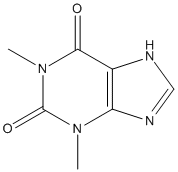Theophylline
Not A/B H target. Theophylline is a natural alkaloid dimethylxanthine derivative of xanthine isolated from the plants Camellia sinensis and Coffea arabica, green and black tea. Theophylline appears to inhibit phosphodiesterase and prostaglandin production, regulate calcium flux and intracellular calcium distribution, and antagonize adenosine. Physiologically, this agent relaxes bronchial smooth muscle, produces vasodilation (except in cerebral vessels), stimulates the CNS, stimulates cardiac muscle, induces diuresis, and increases gastric acid secretion; it may also suppress inflammation and improve contractility of the diaphragm. Theophylline played an important role in the management of both acute and chronic reversible airway obstruction, in particular asthma and chronic bronchitis. However, it has a narrow safety window, which, along with its variability in disposition, makes dosing difficult to predict and toxicity difficult to prevent. Symptoms of toxicity include tachycardia, severe restlessness, agitation, nausea and vomiting, particularly at high blood concentrations
General
Type : Alkaloid,Natural,Purine,Not A\/B H target
Chemical_Nomenclature : 1,3-dimethyl-7H-purine-2,6-dione
Canonical SMILES : CN1C2=C(C(=O)N(C1=O)C)NC=N2
InChI : InChI=1S\/C7H8N4O2\/c1-10-5-4(8-3-9-5)6(12)11(2)7(10)13\/h3H,1-2H3,(H,8,9)
InChIKey : ZFXYFBGIUFBOJW-UHFFFAOYSA-N
Other name(s) : 1,3-Dimethylxanthine,Theophyllin,Elixophyllin,CHEMBL190,CHEBI:28177,ZINC18043251,DB-053224
MW : 180.16
Formula : C7H8N4O2
CAS_number : 58-55-9
PubChem : 2153
UniChem : ZFXYFBGIUFBOJW-UHFFFAOYSA-N
IUPHAR :
Wikipedia :

Target
Families : Theophylline ligand of proteins in family: Pectinacetylesterase-Notum
Stucture : 6TUZ Theophylline- human Notum complex
Protein : human-NOTUM
References (11)
| Title : Low-dose theophylline does not exert its anti-inflammatory effects in mild asthma through upregulation of interleukin-10 in alveolar macrophages - Oliver_2001_Allergy_56_1087 |
| Author(s) : Oliver B , Tomita K , Keller A , Caramori G , Adcock I , Chung KF , Barnes PJ , Lim S |
| Ref : Allergy , 56 :1087 , 2001 |
| Abstract : Oliver_2001_Allergy_56_1087 |
| ESTHER : Oliver_2001_Allergy_56_1087 |
| PubMedSearch : Oliver_2001_Allergy_56_1087 |
| PubMedID: 11703224 |
| Title : Concurrent administration of donepezil HCl and theophylline: assessment of pharmacokinetic changes following multiple-dose administration in healthy volunteers - Tiseo_1998_Br.J.Clin.Pharmacol_46 Suppl 1_35 |
| Author(s) : Tiseo PJ , Foley K , Friedhoff LT |
| Ref : British Journal of Clinical Pharmacology , 46 Suppl 1 :35 , 1998 |
| Abstract : Tiseo_1998_Br.J.Clin.Pharmacol_46 Suppl 1_35 |
| ESTHER : Tiseo_1998_Br.J.Clin.Pharmacol_46 Suppl 1_35 |
| PubMedSearch : Tiseo_1998_Br.J.Clin.Pharmacol_46 Suppl 1_35 |
| PubMedID: 9839764 |
| Title : Effect of theophylline on airway responses to inhaled platelet-activating factor in man - Chung_1989_Eur.Respir.J_2_763 |
| Author(s) : Chung KF , Lammers JW , McCusker M , Roberts NM , Nichol GM , Barnes PJ |
| Ref : Eur Respir J , 2 :763 , 1989 |
| Abstract : Chung_1989_Eur.Respir.J_2_763 |
| ESTHER : Chung_1989_Eur.Respir.J_2_763 |
| PubMedSearch : Chung_1989_Eur.Respir.J_2_763 |
| PubMedID: 2680584 |
| Title : Protective effect of oral oxyphenonium bromide, terbutaline and theophylline against the bronchial obstructive effects of inhaled histamine, acetylcholine and propranolol - Koeter_1984_Eur.J.Clin.Pharmacol_26_435 |
| Author(s) : Koeter GH , Meurs H , Jonkman JH , Greving J , Leferink J , Sluiter HJ , de Zeeuw RA , de Vries K |
| Ref : European Journal of Clinical Pharmacology , 26 :435 , 1984 |
| Abstract : Koeter_1984_Eur.J.Clin.Pharmacol_26_435 |
| ESTHER : Koeter_1984_Eur.J.Clin.Pharmacol_26_435 |
| PubMedSearch : Koeter_1984_Eur.J.Clin.Pharmacol_26_435 |
| PubMedID: 6329769 |
| Title : The time course of changes in cyclic nucleotide levels during cholinergic inhibition of positive inotropic actions of isoprenaline and theophylline in the isolated canine ventricular myocardium - |
| Author(s) : Endoh M |
| Ref : Naunyn Schmiedebergs Arch Pharmacol , 312 :175 , 1980 |
| PubMedID: 6250085 |
| Title : Correlation of cyclic AMP and cyclic GMP levels with changes in contractile force of dog ventricular myocardium during cholinergic antagonism of positive inotropic actions of histamine, glucagon, theophylline and papaverine - Endoh_1979_Jpn.J.Pharmacol_29_855 |
| Author(s) : Endoh M |
| Ref : Japanese Journal of Pharmacology , 29 :855 , 1979 |
| Abstract : Endoh_1979_Jpn.J.Pharmacol_29_855 |
| ESTHER : Endoh_1979_Jpn.J.Pharmacol_29_855 |
| PubMedSearch : Endoh_1979_Jpn.J.Pharmacol_29_855 |
| PubMedID: 232199 |
| Title : Postsynaptic facilitatory effects of theophylline on amphibian neuromyal transmission - Kaibara_1978_J.Pharmacol.Exp.Ther_206_670 |
| Author(s) : Kaibara K , Karczmar AG |
| Ref : Journal of Pharmacology & Experimental Therapeutics , 206 :670 , 1978 |
| Abstract : Kaibara_1978_J.Pharmacol.Exp.Ther_206_670 |
| ESTHER : Kaibara_1978_J.Pharmacol.Exp.Ther_206_670 |
| PubMedSearch : Kaibara_1978_J.Pharmacol.Exp.Ther_206_670 |
| PubMedID: 212547 |
| Title : A comparison of the effect of theophylline and cyclic adenosine 3': 5'-monophosphate on the superior cervical ganglion of the rabbit by means of the sucrose-gap method - |
| Author(s) : Dun NJ , Karczmar AG |
| Ref : Journal of Pharmacology & Experimental Therapeutics , 202 :89 , 1977 |
| PubMedID: 195038 |
| Title : Theophylline compounds and myasthenia gravis. II. Clinical report of nine cases - |
| Author(s) : Brumlik J , Jacobs R , Karczmar AG |
| Ref : Clinical Pharmacology & Therapeutics , 14 :380 , 1973 |
| PubMedID: 4349121 |
| Title : Theophylline compounds and myasthenia gravis. I. In vitro studies - |
| Author(s) : Jacobs R , Karczmar AG , Brumlik J |
| Ref : Clinical Pharmacology & Therapeutics , 14 :374 , 1973 |
| PubMedID: 4698565 |
| Title : Theophylline preparations in the treatment of myasthenia gravis - |
| Author(s) : Jacobs R , Brumlik J , Karczmar AG |
| Ref : Trans Am Neurol Assoc , 96 :158 , 1971 |
| PubMedID: 4333996 |